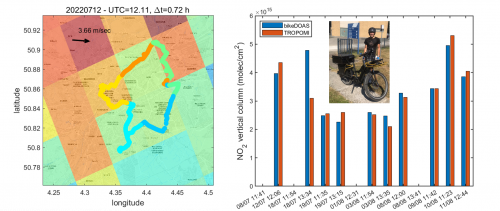NO2 as road traffic pollution marker
Together with fine particles, nitrogen dioxide (NO2) is one of the main pollutants affecting air quality. It is a harmful air pollutant toxic for the respiratory system and a precursor of ozone and particulate matter. It also contributes to the acidification of water and soil.
Because it is produced by combustion, NO2 is considered an excellent marker of road traffic pollution. In particular in densely populated urban areas, it is difficult to regulate and exceedances of European regulations are often reported.
What is the quality of the air we breathe in Brussels?
This question was recently addressed by CurieuzenAir, a large scale citizen science experiment that took place in Brussels from late September to mid-October 2021. During one month, the concentration of NO2 was measured at 2,483 points, scattered throughout the Region revealing a wealth of interesting facts on the distribution of the pollution in the city and its relation to urbanistic and societal aspects.
Inspired by this experiment we decided to equip a SpeedPedelec bicycle with two different NO2 sensors both based on the Differential Optical Absorption Spectroscopy (DOAS) technique, one of them measuring the total column of NO2 above the instrument and the second one (ICAD) dedicated to the quantification of the near-surface NO2 concentration.
This so-called bikeDOAS experiment was set up and tested in Spring 2022 and operated in the field during July-August of the same year, with the help of two enthusiastic young students. Altogether, they traveled approximately 1000 km in the streets of Brussels, sampling the NO2 concentration and vertical column respectively every 2 and 5 seconds. Measurements could be visualized in real-time by means of a dashboard installed in front of the bike.
Results of the bikeDOAS summer campaign
Overall, our results confirm the conclusions of the CurieuzenAir experiment i.e. that in Brussels the pollution is mostly concentrated in the city center. The high frequency of the bikeDOAS measurements allowed to clearly identify local plumes of NO2 directly emitted by individual cars and their quick dispersion in the traffic.
For validation, we successfully compared our measurements with reference data from the Brussels Environment air quality telemetric network. We also focused on a detailed study of the relationship between surface concentration and integrated column data. Finally, NO2 column data were used to verify the accuracy of satellite measurements simultaneously recorded from space by the TROPOMI instrument on board of the Sentinel 5 Precursor satellite platform.

